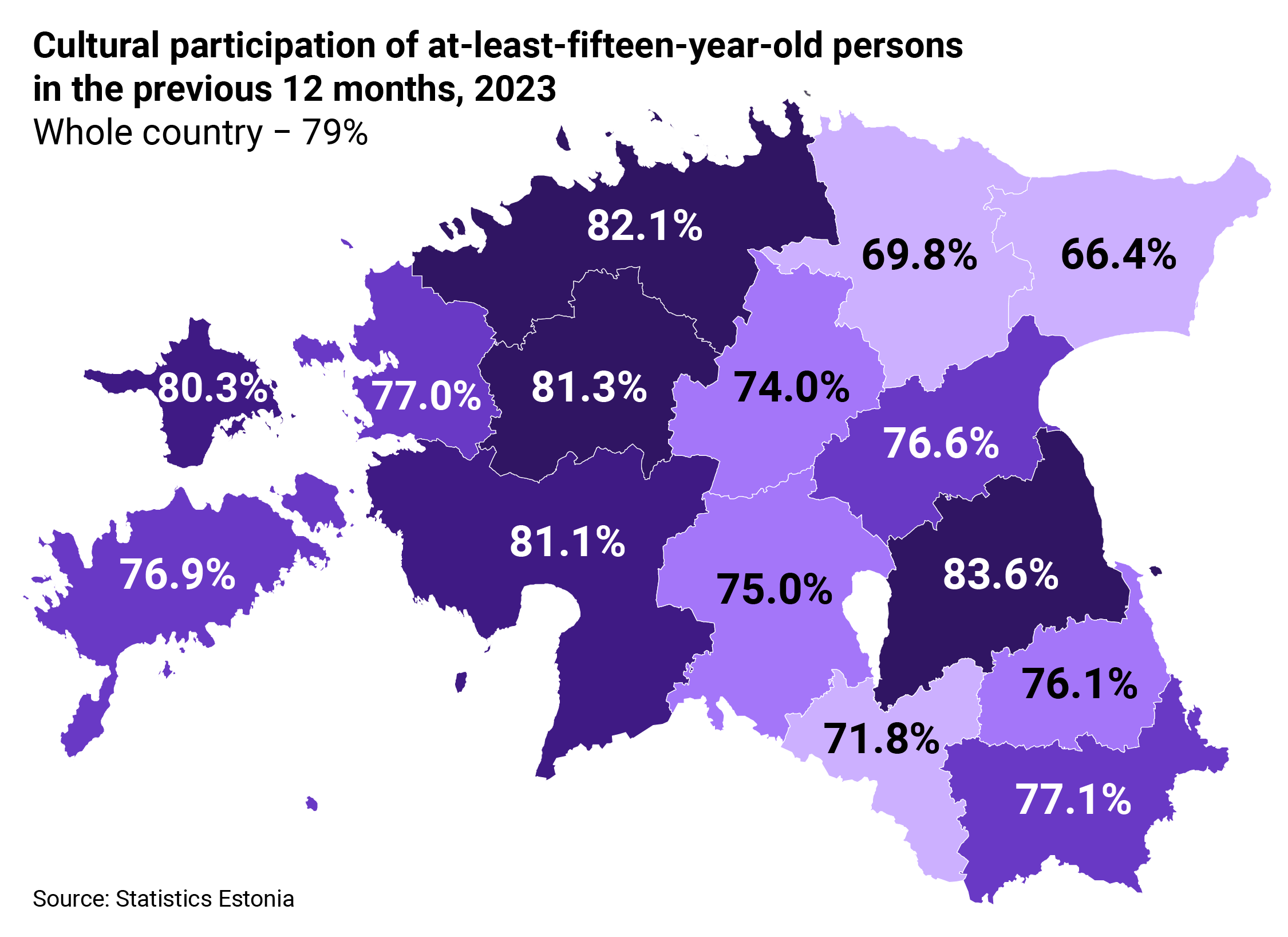Biggest national culture survey: people mainly go to the cinema or a concert for entertainment
The Cultural Participation Survey conducted by Statistics Estonia reveals that over half a million people in Estonia went to the cinema at least once last year. Almost the same number of people attended a concert. Overall, 79% of residents aged 15 and over participated in a cultural event in 2023.
Sigrid Saagpakk, analyst at Statistics Estonia, explained that, in addition to cinema and concert visits, there were also many museum and theatre visits last year. “One in four people showed interest in more innovative formats, such as drive-in cinemas and live-streamed concerts,” she said.
Older people participate less in cultural activities
The survey results show that, based on educational attainment, the level of cultural participation is the highest among people with higher education – 85.9% of them attended a cultural event over the year.
“The level of cultural participation is also very high among students and non-remunerated trainees, with a 98.2% share of participants,” noted Saagpakk. The share of those participating in cultural activities is lower among residents with upper secondary education (75.7%), and residents with below upper secondary education (69.9%).
By age group, participation in cultural activities is more common among young people: as much as 94.4% of 15–24-year-olds attended at least one cultural event over 12 months.
“However, the level of cultural participation tends to fall as people grow older. Thus, the share of those participating in cultural activities was 89.9% in age group 25–44, 80.2% in age group 45–64, and just 54.5% among people aged 65 and over,” added Saagpakk.
Women go more to the library, men attend more sports events
The level of cultural participation is not significantly influenced by a person’s sex. The share of participants among men and women is quite similar – 77.2% and 80.5%, respectively.
The biggest differences occur in visits to libraries, theatres, art galleries, and sports events. “Among women, the share of participants is 17.8 percentage points higher for library visits, 12.2 percentage points higher for theatre visits, and 7.9 percentage points higher for art gallery visits. On the other hand, men visit sports events more often than women,” said Saagpakk.
People like to do sports
During the Cultural Participation Survey, respondents were also asked about their hobbies. Based on the results, 72% of residents have hobbies related to culture.
“The most popular hobby is sports and physical activities, practiced by nearly 486,000 persons in Estonia (43%). Handicraft is also quite popular as a hobby, enjoyed by 213,000 persons (18.9%). Music is a hobby for 97,000 persons, or 8.6% of the population,” said the analyst.
Residents of Tartu county are the most active participants in culture
The survey indicates that the number of persons participating in cultural activities was over 776,000 in urban settlements, which is over two times more than the same number in rural settlements (352,000). “Yet the share of participants in urban areas is slightly lower than in rural areas – 78.2% and 80.6%, respectively. It means that there are no major differences between residents of urban and rural settlements,” said Saagpakk.
In Tartu county, 83.6% of residents participated in at least one cultural activity or event. “This is the highest share of participants in Estonia,” noted Saagpakk. Tartu county was followed by Harju county (82.1%), Rapla county (81.3%) and Pärnu county (81.1%). The share of participants in culture was the lowest in Ida-Viru and Lääne-Viru counties, where it was under 70% in each.
Ministry: the share of residents participating in cultural life should be at least 80%
Karl Viilmann, chief data expert at the Ministry of Culture, said that the Cultural Participation Survey is the biggest national survey in this domain and the collected data are used to set national targets concerning the arts, cultural goods, and sports.
“The results of the survey allow us to assess national cultural policy, which in turn informs the Culture Development Plan. The same indicators also feature in several key national strategies, such as “Estonia 2035” and the sustainable development goals,” he explained.
Viilmann said that, as defined in the Culture Development Plan, the target level for share of Estonian residents participating in cultural life is 80% by 2030. “For comparison, this share was 73.8% in 2020, 78.7% in 2017, and 84.4% in 2015,” he added.
The main representative of public interest for the Cultural Participation Survey is the Ministry of Culture. The survey provides information about people’s cultural interests and habits, which is used for policymaking and development of cultural services in Estonia.
More information about the Cultural Participation Survey is available on Statistics Estonia’s website.
More detailed data have been published in the statistical database.
When using Statistics Estonia’s data and graphs, please indicate the source.
For further information:
Heidi Kukk
Media Relations Manager
Marketing and Dissemination Department
Statistics Estonia
Tel +372 625 9181
